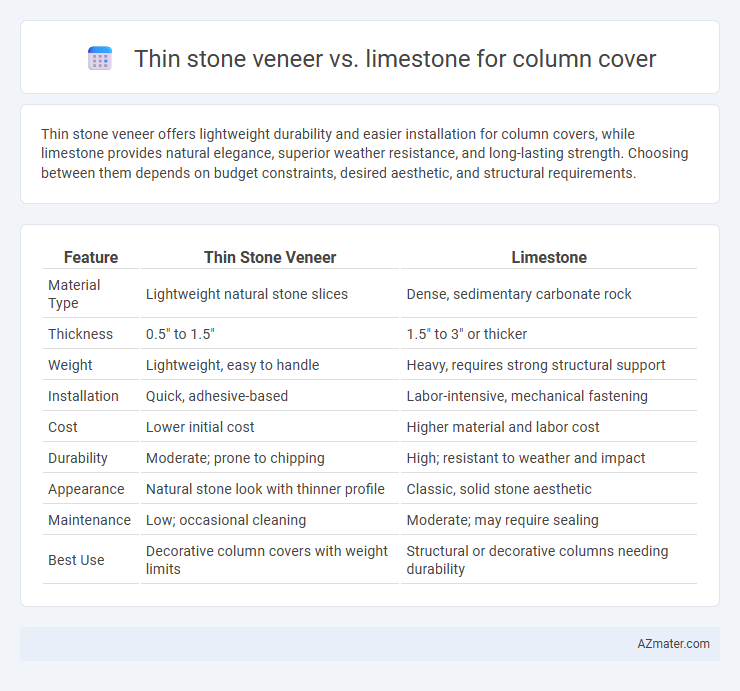Thin stone veneer offers lightweight durability and easier installation for column covers, while limestone provides natural elegance, superior weather resistance, and long-lasting strength. Choosing between them depends on budget constraints, desired aesthetic, and structural requirements.
Table of Comparison
| Feature | Thin Stone Veneer | Limestone |
|---|---|---|
| Material Type | Lightweight natural stone slices | Dense, sedimentary carbonate rock |
| Thickness | 0.5" to 1.5" | 1.5" to 3" or thicker |
| Weight | Lightweight, easy to handle | Heavy, requires strong structural support |
| Installation | Quick, adhesive-based | Labor-intensive, mechanical fastening |
| Cost | Lower initial cost | Higher material and labor cost |
| Durability | Moderate; prone to chipping | High; resistant to weather and impact |
| Appearance | Natural stone look with thinner profile | Classic, solid stone aesthetic |
| Maintenance | Low; occasional cleaning | Moderate; may require sealing |
| Best Use | Decorative column covers with weight limits | Structural or decorative columns needing durability |
Introduction to Column Cover Materials
Thin stone veneer and limestone are popular choices for column covers due to their durability and aesthetic appeal. Thin stone veneer offers lightweight installation with natural stone textures, making it ideal for both interior and exterior applications. Limestone provides a classic, elegant finish with excellent weather resistance, suitable for enhancing architectural columns with a timeless look.
Overview of Thin Stone Veneer
Thin stone veneer offers a lightweight, cost-effective alternative to traditional limestone for column covers, providing the natural aesthetic of stone with easier installation and reduced structural load. Made from real stone slices, thin stone veneer retains the durability and texture of full-thickness limestone while significantly cutting material and labor expenses. Its versatility allows for seamless application on various column shapes, enhancing architectural appeal without compromising strength.
Understanding Natural Limestone
Natural limestone offers unique mineral compositions and textures that provide authentic aesthetics and durability for column covers compared to thin stone veneer. Limestone's porous structure allows for better breathability and weather resistance, making it a superior choice in outdoor architectural applications. Thin stone veneer, while lightweight and easier to install, lacks the natural variation and long-term resilience inherent in genuine limestone.
Aesthetic Differences: Thin Stone Veneer vs Limestone
Thin stone veneer offers a versatile range of textures and colors, enabling a modern or rustic aesthetic with its lightweight and flexible application, ideal for creating detailed or layered column designs. Limestone provides a classic, natural elegance with its uniform grain and subtle color variations, delivering timeless sophistication and durability for structural and decorative column covers. The choice between thin stone veneer and limestone for columns largely depends on the desired visual impact, maintenance preferences, and architectural style integration.
Durability and Longevity Comparison
Thin stone veneer offers excellent durability with resistance to cracks and chips, making it ideal for column covers exposed to varying weather conditions. Limestone, while aesthetically appealing and historically favored for architectural details, is softer and more porous, requiring regular sealing to maintain longevity and prevent erosion. Choosing thin stone veneer over limestone can result in lower maintenance costs and extended lifespan for exterior columns.
Installation Process: Veneer vs Limestone
Thin stone veneer offers a lightweight and flexible installation process, typically applied using a mortar adhesive directly onto the column surface, allowing for quicker and less labor-intensive application compared to traditional limestone. Limestone columns require skilled masonry work, involving heavy stone blocks that must be precisely cut, fitted, and anchored, extending installation time and costs. The veneer method reduces structural load and simplifies modifications, whereas limestone demands structural support and professional handling to ensure durability and stability.
Maintenance Requirements
Thin stone veneer requires minimal maintenance, often needing just occasional cleaning with mild soap and water to preserve its appearance. Limestone, being a porous natural stone, demands regular sealing to prevent staining and weathering, and may require more frequent repairs due to its susceptibility to chipping and erosion. Choosing thin stone veneer over limestone significantly reduces long-term maintenance efforts and associated costs for column covers.
Cost Analysis and Budget Considerations
Thin stone veneer offers a cost-effective alternative to traditional limestone for column covers, significantly reducing material and installation expenses due to its lighter weight and easier application. Limestone, while providing superior durability and a classic aesthetic, entails higher upfront costs and increased labor requirements, impacting overall budget allocation. Evaluating the balance between initial investment and long-term value is essential for selecting the optimal material within budget constraints.
Environmental Impact and Sustainability
Thin stone veneer offers a more sustainable alternative to limestone by requiring less raw material extraction, which reduces habitat disruption and carbon emissions during quarrying. Limestone, while durable and natural, involves intensive mining processes that contribute to resource depletion and higher environmental footprints. Choosing thin stone veneer enhances resource efficiency and minimizes ecological impact for column covers without sacrificing the authentic stone appearance.
Best Applications for Each Material
Thin stone veneer offers a lightweight, cost-effective solution ideal for residential column covers where ease of installation and aesthetic versatility are priorities. Limestone provides superior durability and natural weather resistance, making it the best choice for exterior columns exposed to harsh environmental conditions. Both materials enhance architectural appeal, but thin stone veneer suits decorative applications while limestone excels in structural longevity.

Infographic: Thin stone veneer vs Limestone for Column cover
 azmater.com
azmater.com